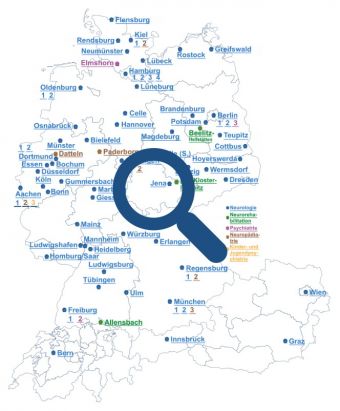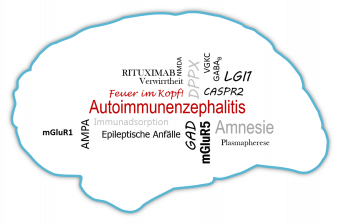When and how is it appropriate to search for an underlying tumor?
In seropositive autoimmune encephalitides, the probability and most common localization of an underlying tumor can be predicted regardless of the detected neuronal antibody (Table 1). Of course, risk factors (e.g. smoking history), age and gender should also be taken into account in these considerations. Tumor diagnostics should be graded (Table 2).
Tabelle 1: Association between cancer and the most common antineuronal antibodies. SCLC = Small cell lung cancer, LEMS = Lambert-Eaton myasthenic syndrome, DNER = Delta/notch-like epidermal growth factor-related receptor, *in some patients Ma antibodies coexist, meaning that brainstem syndromes and non-testicular tumors will predominate.
|
Antibody |
Most common cancers |
|
Antibodies against intracellular antigens (onconeural antigens). Cancer-related >95% |
|
|
Anti-Hu (ANNA-1) |
Lung cancer (85%), mostly SCLC, neuroblastoma, Merkel cell carcinoma, other tumors with neuroendocrine differentiation |
|
Anti-Yo (PCA-1) |
Ovarian cancer, breast cancer |
|
Anti-CV2/CRMP5 |
SCLC, thymoma |
|
Anti-Ta/Ma2* |
Testicular tumor |
|
Anti-Ri (ANNA-2) |
Breast cancer, ovarian cancer, SCLC |
|
Anti-amphiphysin |
Breast cancer, SCLC |
|
Anti-recoverin |
SCLC |
|
Anti-SOX-1 (AGNA) |
SCLC (in LEMS) |
|
Anti-Tr (PCA-Tr), DNER |
Hodgkin's, non-Hodgkin's lymphoma |
|
Anti-Zic4 |
SCLC (idiopathic forms known, cancer-related <90%) |
|
Antibodies against synaptic antigens (neuronal surface antigens). Variable cancer relationship |
|
|
Anti-NMDA receptor |
Age and gender dependent. Women aged between 12-45 years in Germany |
|
Anti-AMPA receptor |
SCLC, thymoma, breast cancer (50%) |
|
Anti-GABA(B) receptor |
SCLC (50%) |
|
Anti-LGI1 |
Thymoma (<5%) |
|
Anti-CASPR2 |
Depending on the syndrome: Limbic encephalitis various tumors <5%; Morvan syndrome (40%) |
|
Anti-mGluR5 |
Hodgkin’s lymphoma (approx. 50%) |
|
Anti-DPPX |
B cell neoplasms (<10%) |
|
Anti-GABA(A) receptor |
Thymoma (30%) |
|
Anti-neurexin-3α |
Not known |
|
Anti-IgLON5 |
No known cancer relationship |
Modified after the Practice Guideline on “Paraneoplastic Syndromes” issued by the German Neurological Society (DGN)
Table 2: Graded tumor diagnostics guided by the presumed localization for select tumors. Sensitivity in parentheses, if known. EB-US = Endobronchial ultrasound
| Cancer | Diagnostics | ||
|---|---|---|---|
| Primary | Secondary | Tertiary | |
| Lung cancer | Chest CT (80-85%), Chest MRI |
FDG-PET or FDG-PET/CT | Bronchoscopy/EB-US and, if indicated, fine-needle aspiration Mediastinoscopy, if indicated |
| Thymoma | Chest CT (75-90%), Chest MRI |
FDG-PET or FDG-PET/CT | |
| Breast cancer | Mammography (80%), Ultrasound |
Breast MRI | |
| Ovarian cancer | Transvag. ultrasound (69-90%) + CA-125 | Pelvic/abdominal CT | FDG-PET or FDG-PET/CT |
| Ovarian teratoma | Transvag. ultrasound (69-90%) | MRI (93-98%) | Chest CT (extrapelvic teratomas) |
| Testicular tumors | Ultrasound (72%) + β-HCG, AFP | Pelvic/abdominal CT (76%), abdominal MRI |
If indicated FDG-PET or FDG-PET/CT (malignant teratomas) |
| Lymphoma | Chest CT/abdominal ultrasound | FDG-PET or FDG-PET/CT | |
| Skin cancer (Merkel cell carcinoma) | Dermatological examination Biopsy, if applicable |
||
Modified after the Practice Guideline on “Paraneoplastic Syndromes” issued by the German Neurological Society (DGN)


